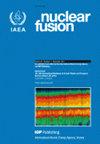Studies of the outer-off-midplane lower hybrid wave launch scenario for plasma start-up on the TST-2 spherical tokamak
IF 4
1区 物理与天体物理
Q1 PHYSICS, FLUIDS & PLASMAS
引用次数: 0
Abstract
Establishment of an efficient central solenoid (CS) free tokamak plasma start-up method may lead to an economical fusion reactor. CS-free start-up using lower hybrid (LH) waves has been studied on the TST-2 spherical tokamak. Plasma current of about a quarter of CS-driven discharges has been obtained fully non-inductively using the outer-midplane and top LH launchers. Recently, an outer-off-midplane LH launcher was developed to achieve higher plasma current by optimizing for core absorption and minimal fast electron losses. Using the (outer-)off-midplane launcher, fully non-inductive plasma current start-up up to about 8 kA was achieved. Coupled ray-tracing and Fokker–Planck simulation was performed on equilibria reconstructed with an extended MHD model. It was found that the experimentally observed plasma current was in reasonable agreement with the numerical simulation. The simulation predicted appreciable orbit losses for the off-midplane launcher driven discharge at the present parameters, which was consistent with the experimentally observed x-ray radiation characteristics. The simulation showed that the current density was saturated for the present off-midplane launcher discharges and higher density and higher LH power was necessary to achieve higher plasma current.研究用于 TST-2 球形托卡马克等离子体启动的外偏中平面下混合波发射方案
建立一种高效的无中央螺线管(CS)托卡马克等离子体启动方法可能会带来经济的聚变反应堆。我们在 TST-2 球形托卡马克上研究了利用下混合(LH)波的无 CS 启动方法。利用外-中平面和顶部 LH 发射器,以完全非感应方式获得了约四分之一 CS 驱动放电的等离子体电流。最近,又开发了一种外侧偏离中平面的 LH 发射器,通过优化核心吸收和减少快速电子损耗来获得更高的等离子体电流。利用(外)离中平面发射器,实现了完全无感的等离子体电流启动,最高可达约 8 kA。对用扩展 MHD 模型重建的平衡进行了射线追踪和福克-普朗克耦合模拟。结果发现,实验观测到的等离子体电流与数值模拟结果相当吻合。模拟预测,在目前的参数下,偏离中平面发射器驱动的放电会产生明显的轨道损耗,这与实验观测到的 X 射线辐射特性是一致的。模拟结果表明,目前的偏离中平面发射装置放电的电流密度已经饱和,需要更高的密度和更大的 LH 功率才能获得更高的等离子体电流。
本文章由计算机程序翻译,如有差异,请以英文原文为准。
求助全文
约1分钟内获得全文
求助全文
来源期刊

Nuclear Fusion
物理-物理:核物理
CiteScore
6.30
自引率
39.40%
发文量
411
审稿时长
2.6 months
期刊介绍:
Nuclear Fusion publishes articles making significant advances to the field of controlled thermonuclear fusion. The journal scope includes:
-the production, heating and confinement of high temperature plasmas;
-the physical properties of such plasmas;
-the experimental or theoretical methods of exploring or explaining them;
-fusion reactor physics;
-reactor concepts; and
-fusion technologies.
The journal has a dedicated Associate Editor for inertial confinement fusion.
 求助内容:
求助内容: 应助结果提醒方式:
应助结果提醒方式:


